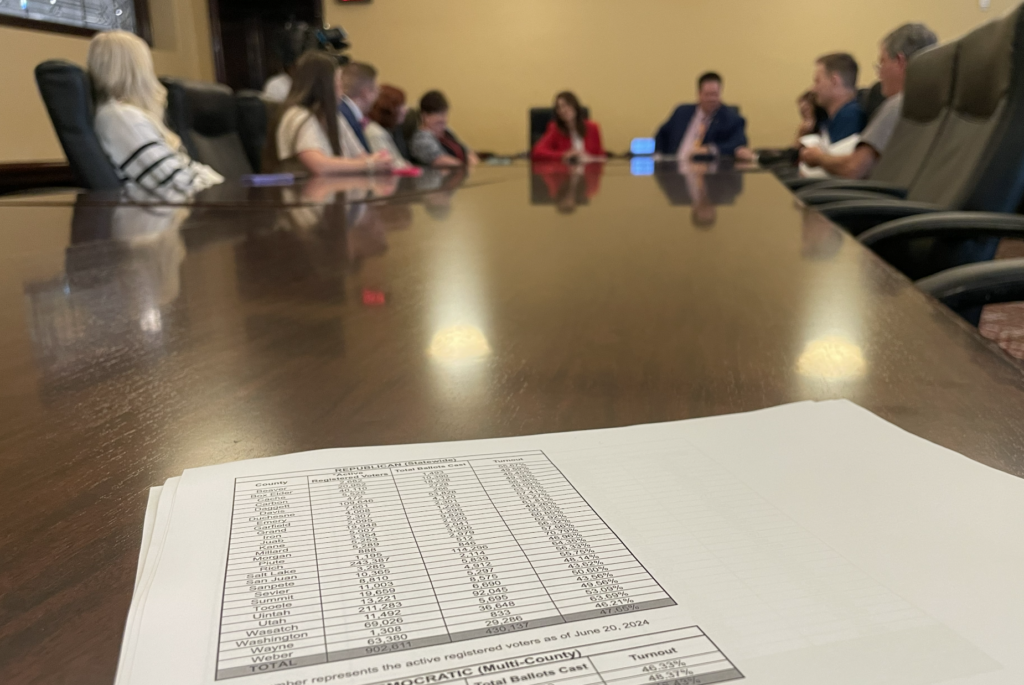Utah’s 2024 Republican primary saw lower voter turnout compared to record-setting 2020

- Oops!Something went wrong.Please try again later.
- Oops!Something went wrong.Please try again later.
A printed copy of election results for Utah's 2024 primary sit on a desk as Lt. Gov. Deidre Henderson canvasses election results at the Utah Capitol in Salt Lake City on July 22, 2024. (Katie McKellar / Utah News Dispatch)
Now that Utah’s 2024 primary has been certified, we have a complete picture of how many Utahns participated in the June 25 election.
Even though Utah’s Republican primary this year was packed full of high-profile and heated races — including the gubernatorial race between Gov. Spencer Cox and Rep. Phil Lyman, a crowded GOP contest to replace outgoing Sen. Mitt Romney, and a neck-and-neck battle for the 2nd Congressional District — primary voter turnout was low compared to the last presidential election year, in 2020, when voter turnout reached record highs across the country and in Utah.
Out of 902,611 active registered Republican voters, only 430,137 cast votes in this year’s GOP primary, or 47.65%, according to election results certified by Lt. Gov. Deidre Henderson on Monday.
Compare that to the 527,178 active registered Republican voters who voted in the statewide GOP gubernatorial primary in 2020, when then-lieutenant governor Cox competed against Jon Huntsman Jr., Thomas Wright and former House Speaker Greg Hughes. That year in June, historical state election records show Utah had 778,623 active registered Republican voters. Of those, about 67.7% participated in that primary.
This year’s Republican primary turnout falls closer to the 2022 primary, when 416,703 Republicans voted in the U.S. Senate contest between incumbent Sen. Mike Lee, and his challengers Ally Isom and Becky Edwards.
Though this year marks a presidential election year, when voter participation usually peaks, last month’s primary saw only 13,434 more Republican voters participate compared to the 2022 primary. That year, the state’s tally of active registered Republican voters in June was 874,114, so statewide turnout for the Republican primary for U.S. Senate was about 47.67% — a sliver more than this year’s.
Primaries typically don’t see as much voter participation as general elections — but this year saw comparatively lower numbers for a presidential year, especially compared to record turnout levels in 2020. Even though the state had nearly 124,000 more active registered GOP voters on its rolls compared to 2020, nearly 100,000 fewer participated in this year’s primary election.
Certified election results show turnout varied widely county to county, with the highest Republican turnout percentage-wise in rural Rich County, with nearly 70.8% (846 ballots cast). In sheer numbers, urban Salt Lake County saw the most votes cast, with 114,296, but that made up about 47% turnout.
Though Lyman lost to Cox by 37,525 votes (45.6% to Cox’s 54.5%), one of Lyman’s strongholds, his home county of San Juan, saw one of the highest turnouts with about 64% (2,114 votes), while another southern Utah community where he won big, Washington County, had a 53% turnout (36,648 votes).
However, the conservative Wasatch Front area of Utah County saw the lowest GOP voter turnout, with 43.56% (92,045 votes). Tooele County ranked second lowest, with 43.62% (8,575 votes).
Factors that could have affected voter turnout
The year 2020 was an anomaly, with extraordinary high levels of voter engagement during a presidential year. But this year’s primary, even though it also came during a presidential election year, was no better than 2022, when there were far fewer high-profile races on the ballot.
Aside from voter disinterest or disengagement — with about 65% of Americans feeling exhausted with today’s polarized political climate, according to recent research by Pew Research Center — some other factors could have influenced this year’s turnout.
Utah County Clerk Aaron Davidson faced some controversy after county officials decided to stop paying for return postage on mail-in ballots, leading some to worry it would suppress voter turnout. Most voters who did participate in Utah County’s primary dropped off their ballots in voting drop boxes rather than mail them, KSL-TV reported. Compared to about 37% in the 2022 primary, Utah County’s turnout this year was higher — but it was lower compared to 53.26% in the 2020 primary, according to county records.
GET THE MORNING HEADLINES DELIVERED TO YOUR INBOX
This year’s primary also stirred frustrations, especially among rural counties like Iron County, over voting by mail and ballots being disqualified for missing the deadline for postmarking, which is required no later than the day before Election Day under Utah law. In Iron County, where mail is processed in Las Vegas, leading one commissioner to vote against certifying the election, nearly 500 ballots were disqualified because they weren’t postmarked on time to be legally counted.
The postmarking issue was especially highlighted in the GOP 2nd Congressional District Race. Rep. Celeste Maloy won by only 214 votes — within the margin that allows losing candidates to call a recount. Her challenger Colby Jenkins and his campaign have said they plan to call a recount, hoping it will allow more late-postmarked ballots to be counted.
However, given Iron County officials ultimately voted to certify because state law is clear they can’t be legally counted without a postmark before Election Day, it’s unlikely that a recount will result in a flood of previously uncounted ballots. Though lawmakers aren’t planning to act to affect this year’s race, at least one legislator plans to file a bill to allow more flexibility for election officials when it comes to counting by-mail ballots in rural counties.
Here’s a county-by-county breakdown of voter turnout in Utah’s Republican primary, according to certified election results:
The post Utah’s 2024 Republican primary saw lower voter turnout compared to record-setting 2020 appeared first on Utah News Dispatch.

